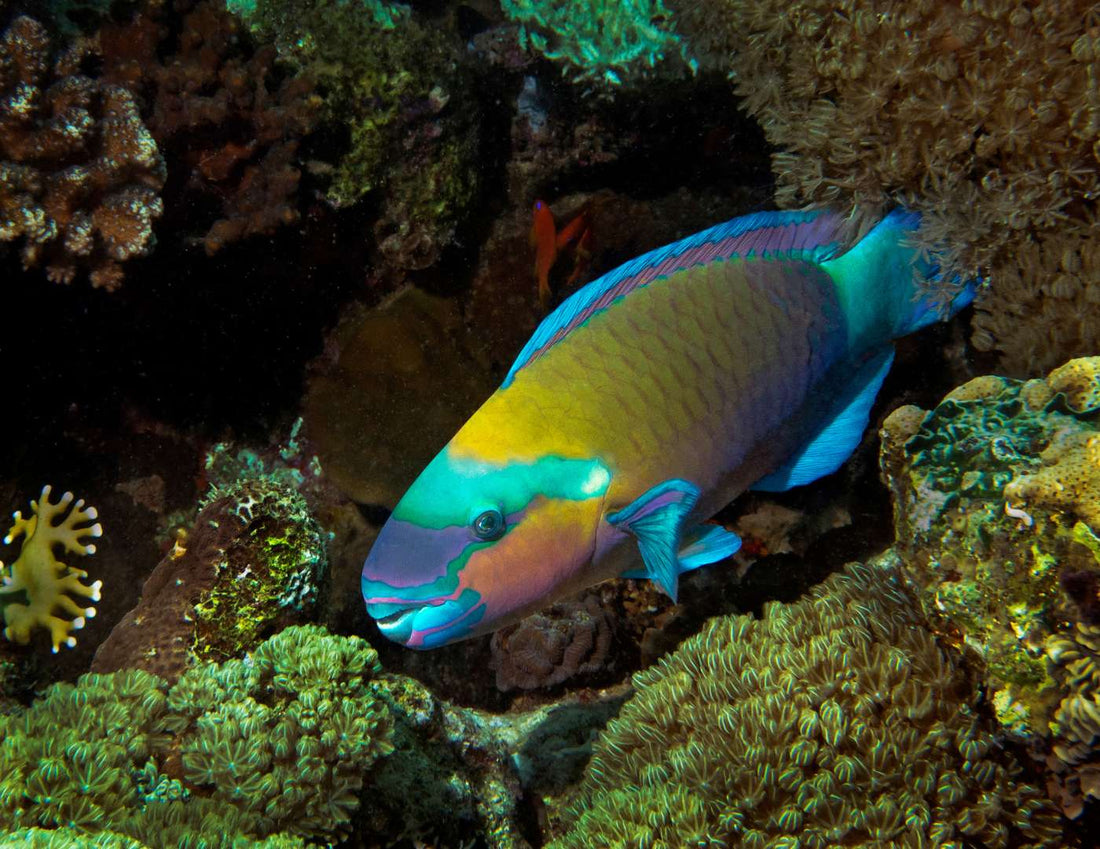
Parrotfish: The Fish That Creates Sand and Protects Corals
BY NAMUBAKShare
Imagine a white-sand beach, crystal-clear water, and a reef teeming with life. What you may not know is that some of that sand you're standing on was created by a fish. The parrotfish, with its vibrant colors and beak-like mouth, is not just a visual gem of the ocean: it's a silent ecological engineer that builds beaches, cleans reefs, and balances entire ecosystems. Today, we invite you to learn more about it, understand its importance, and learn why its conservation is so urgent.

The invisible impact of the parrotfish
Although it may seem incredible, the parrotfish produces white sand. Feeding on dead coral and algae, it grinds the substrate with its strong beak and excretes it as fine sand. A single individual can generate up to 90 kilos of sand per year , contributing to the natural formation of tropical beaches around the world.
But their role goes far beyond that. By keeping algae growing on corals in check, they allow them to breathe, regenerate, and maintain ecosystem balance. Without parrotfish, coral reefs become overgrown with algae, deteriorate, and lose biodiversity.
If you are interested in learning more about this essential ecosystem, visit our blog on the importance of coral reefs.
A life cycle as fascinating as it is necessary
The parrotfish also features an unusual reproductive strategy: it is a proterogynous hermaphrodite. It is born female and, depending on social and environmental conditions, can transform into a male. In its group, a single alpha male leads a harem of females. If he disappears, one of the females takes over his role… but this change takes weeks or even months, which directly affects the reproductive rhythm of the group.
Their colors also change depending on the life stage. In their terminal phase (when they are adult males), they display more intense and contrasting hues. Therefore, identifying a parrotfish species may require knowing two distinct color patterns.

A rainbow of species under the sea
There are more than 90 species of parrotfish distributed throughout the reefs of the Caribbean, the Indo-Pacific, the Red Sea, and other tropical regions of the Pacific. Some of the most representative include:
- Scarus ghobban , blue parrotfish
- Scarus compressus , blue-green with orange fins
- Scarus rubroviolaceus , round-headed bicolor
- Scarus perrico , the majestic humpback parrotfish
- Nicholsina denticulata , brown in color and with loose teeth
Each contributes uniquely to the ecological balance, depending on its size, diet, and habitat.
Curious things also matter: 5 things you didn't know about the parrotfish
- At night, it wraps itself in a bubble of mucus to hide its scent from predators.
- Its beak-like mouth is made for crushing coral and algae.
- It is a natural sand creator: it literally makes beaches.
- Its colors act as camouflage among the corals.
- It can change sex if the group needs it.

Is the parrotfish in danger?
The parrotfish is in serious danger. Overfishing, pollution, and climate change threaten its existence.
In many places, such as Costa Rica, its fishing has been banned since 2012 due to its ecological importance. However, in unregulated regions, it continues to be caught, weakening reefs and affecting the entire marine ecosystem.
Parrotfish are not easily replaced. Their ecological role—cleaning reefs, maintaining algal balance, and creating sand—cannot be assumed by another species. Therefore, fishing for parrotfish has devastating consequences for corals, beaches, and marine life.

Protecting the parrotfish is protecting an entire ecosystem
Imagine a lifeless reef, covered in algae, devoid of color and fish. Now imagine a healthy one, filled with corals, turtles, and colorful fish. A single parrotfish can make that difference.
One of the best ways to learn about their habitat and support their protection is to practice responsible diving . This activity allows you to explore reefs firsthand without leaving a negative impact.
At Namubak, we believe that knowledge is the first step toward conservation. That's why we share these stories. Because every decision, every action, every piece of clothing you wear, and every experience you have can contribute to ocean protection.

